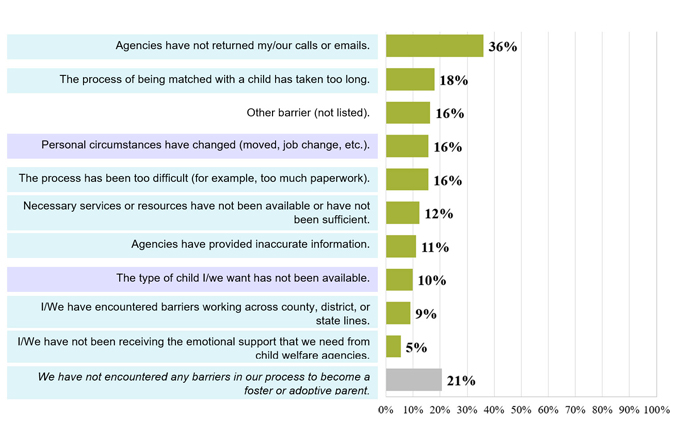
As you seek to expand your pool of foster, adoptive, and kinship families who can meet the needs of children in foster care, you may be particularly focused on finding the best recruitment strategies. While important, recruiting families is only the first step; it’s crucial to have an effective, consistent approach for responding to and engaging inquiring families.
By combining data on your own response system with effective strategies for keeping families engaged and breaking down barriers, you can increase the number of families who move forward to licensure or approval and become resources for children in foster care.
Barriers identified by families in our surveys
AdoptUSKids uses a Family Intake Tracking Tool (FITT) to support communication with and services to prospective foster and adoptive families. FITT includes, among other functions, a series of surveys automatically sent to families who contact AdoptUSKids for information.
In addition to feedback related to AdoptUSKids services, families are also asked about their process to foster or adopt from foster care, including any barriers and biases they encounter.
This article summarizes barriers data from 3,785 survey respondents. Over three-quarters of these families indicated encountering one or more barriers in their current process to become a foster or adoptive parent. The two most frequently reported barriers were:
- Agencies had not returned families’ calls or emails
- It took too long to become matched with a child
Chart: Barriers reported by families

“Other” barriers include a variety of topics, such as concerns about costs, delays, and scheduling challenges, as well as explanations for their answers about listed barriers.
Your child welfare system may have slightly different barriers that families encounter, or the percentages of families who experience the barriers might differ from this national data, but these findings can be helpful as you seek to reduce common barriers and support families through the process.
Challenges identified by families and child welfare staff
Through our work with families and child welfare systems across the country, we hear a lot about what families experience moving from inquiry to licensure or approval.
The themes we hear in those discussions align with what we see in our national survey data about the challenges families encounter:
- Delays in getting a response from an agency after initially inquiring about fostering or adopting, and delays in being connected with the right contact person or team to move forward in the process
- Agencies prioritizing responding to specific categories of families, meaning that some families (e.g., families who are only interested in adopting) may have to wait longer for a response
- Limited access to orientation or training, including long delays before starting orientation or preservice training sessions
- Delays in licensure or approval steps, such as long waits for background checks and slow processing time for paperwork
- Response messages and steps in the process that don’t make families feel welcome or valued, such as a lack of a timely and supportive response and intake forms and processes that aren’t inclusive and culturally competent from families’ perspectives
Ways you can address these barriers and challenges and strengthen your response and engagement efforts
- Return families’ calls and emails promptly. Although there are many strategies that are helpful for keeping families engaged and feeling valued, one of the most consistent challenges that prospective and current foster and adoptive parents report is not hearing back from staff in response.
- Provide clear, consistent information about the licensure or approval process and requirements. This includes estimated time frames and what to expect at each step.
- Use customer service approaches to provide a more engaging and supportive experience for families. By implementing customer service strategies for welcoming and supporting families and keeping them engaged as they navigate through the inquiry-to-licensure process, you can improve their experience and demonstrate that you value them. Learn more about our customer service model.
- Use concurrent steps to streamline the process. Rather than having separate steps for paperwork, training, background checks, and other key steps for preparing and approving families, you can shorten timelines by doing some steps concurrently. For example, some systems start families’ background checks early in the preservice training process so the time needed for the background check doesn’t slow the process down.
- Use process mapping to streamline the process and eliminate or reduce barriers for families. Process mapping involves creating a visual representation of your child welfare system’s process for prospective parents, from responding to inquiries to conducting licensures and home studies. Using this approach—with input from families and staff—can help you identify possible barriers, areas of duplication, unnecessary steps or paperwork, and other opportunities for improvement that can make your process easier and more welcoming to prospective parents. This can lead to more families making it through your process more efficiently.
- Support families through barriers or challenges that can’t be eliminated. Some parts of the inquiry-to-licensure process may have unavoidable waits or delays, such as waiting for the results of a background check or other steps that may rely on external agencies. Though this part of the process is largely out of your control, the experience is still frustrating for families. Prepare prospective parents for these hurdles and be available to support them when challenges arise.
- Consider conducting your own survey. You may decide at some point that you want to collect your own data to determine what barriers your families experience. If so, we encourage you to consider how best to collect and analyze meaningful data within the context of your available staff time and other priorities.
We’re here to help!
Contact us at consultation@adoptuskids.org to find out about our free capacity-building services for states, tribes, and territories and to explore ways we can support you in developing tailored strategies for strengthening your response system.
About the data: Over the last five and a half years, families who contacted AdoptUSKids responded to 6 percent of these overall survey invitations as of March 31, 2020. Given that respondents may have completed more than one these surveys across this period, this article focuses each respondent’s most recently completed survey. Most survey respondents indicated they were married and most were in a heterosexual relationship. Most respondents reported White as their race and indicated they were in their thirties or forties. Over three-quarters of respondents indicated being interested in pursuing either adoption or both foster care and adoption. Most respondents reported never having fostered or adopted. Almost all respondents provided an address within the United States, and respondents reported living in all 50 states, Washington, DC, Guam, and Puerto Rico.